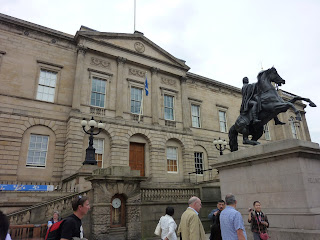
Sally Brock started our tour with an introduction to King's College and the history of the Maughan Library. King's College (Strand campus) was founded in 1829. The Strand campus is the only non-health related studies campus. Studies at the Strand campus include the humanities, law, and sciences. In the beginning, the library was seperated into several libraries. It was considered to be a mish-mash of books, with no room for expansion. The building the library is currently located became up for grabs in the 1990s. King's is leasing the building because it falls on royal property, and the Queen is a patron of King's. In 2001, the Maughan Library opened.
The building was formerly a public record office, built in the 1850s. It was the first fireproof building in London. This building was ideally built in the heart of London, making it convenient to store records. The building was designed with only a few public rooms. Changes were made to allow more public rooms- there are 1,000 reader places and over 800 computer terminals located in Maughan. The collection includes 750,000 items. The stacks are primarily open stacks, with special collections as an exception. King's students, researchers, faculty and staff, and other students affiliated with King's are allowed access to the collection. Over the past 10 years, the Maughan Library has underwent a few changes to become more patron friendly. Wireless connection, 24/7 access during finals week, social seating areas, and flexible teaching spaces have been included in the changes. Other features of the library include the short loan room and the round reading room. Obviously, books with a short loan period are placed in the short loan room. The round reading room is meant for silent study. Patrons who enter this room are well aware of the room's serious tone. This room has also been frequently used for filming purposes. The room gives a hint of what a library should look like. The stacks are round, encircling the entire room from floor to ceiling with books.
The Foyles special collections includes 150,000 items and 12 reader spaces. The collection is rich in the medical field, including Florence Nightingale's works. Foyles doesn't have a large acquisitions budget. They receive between 10-12 new items per year. There are 3 staff members full-time. The reading room is closely monitored by staff, and the patrons may only look at materials in the reading room. Anyone with a student ID is allowed to use the collection. Most users are post graduate and research students. One of the items shown was a rare Low German Bible. It was printed in Halberstadt in 1520. There was an illustration on one page of the 4 horses mentioned in Revelations.











